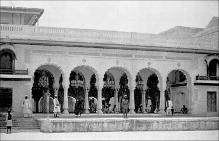Deori Iqbaluddawlah
Bahadur, Nawab Vikar-ul-Umra; Shams al-Umara I

Download111245_cp.jpg (781.2Kb)
Date
1770-1791Description
Located in Shahganj, Shams al-Umara I built the deori in the late 18th century in an oriental style. His successor Sir Wiqar al-umara II, who also had the title of Iqbaluddawlah (1856-1902) remodeled portions of the palace after European fashion to entertain foreign visitors. It is often referred to as the city palace, deori baldah, in contradiction to the Falak Numa Palace and the Paigah Palace he built in the then suburbs of the city. The palace consisting of four quadrangles with a central cistern was divided into zenana and sleeping quarters, dining, drawing rooms, and offices. The palace fell into disuse after the nobleman’s move to Paigah Palace in Begumpet at the turn of the 20th century. The portion surviving in 2006 consists of a façade facing the street with projected and canopied windows. exterior, Closer view of the of the entrance to the old Deori showing an arched gallery and the gate, 1890s
Type of Work
PalaceSubject
Palaces, Islamic cities and towns, Architecture, Islamic --India, Lost architecture, Paigah family, Anglo-Mughal, Architecture, Oriental, Deccan (India), Gates, Galleries (Architecture)
Item is Part of
130508